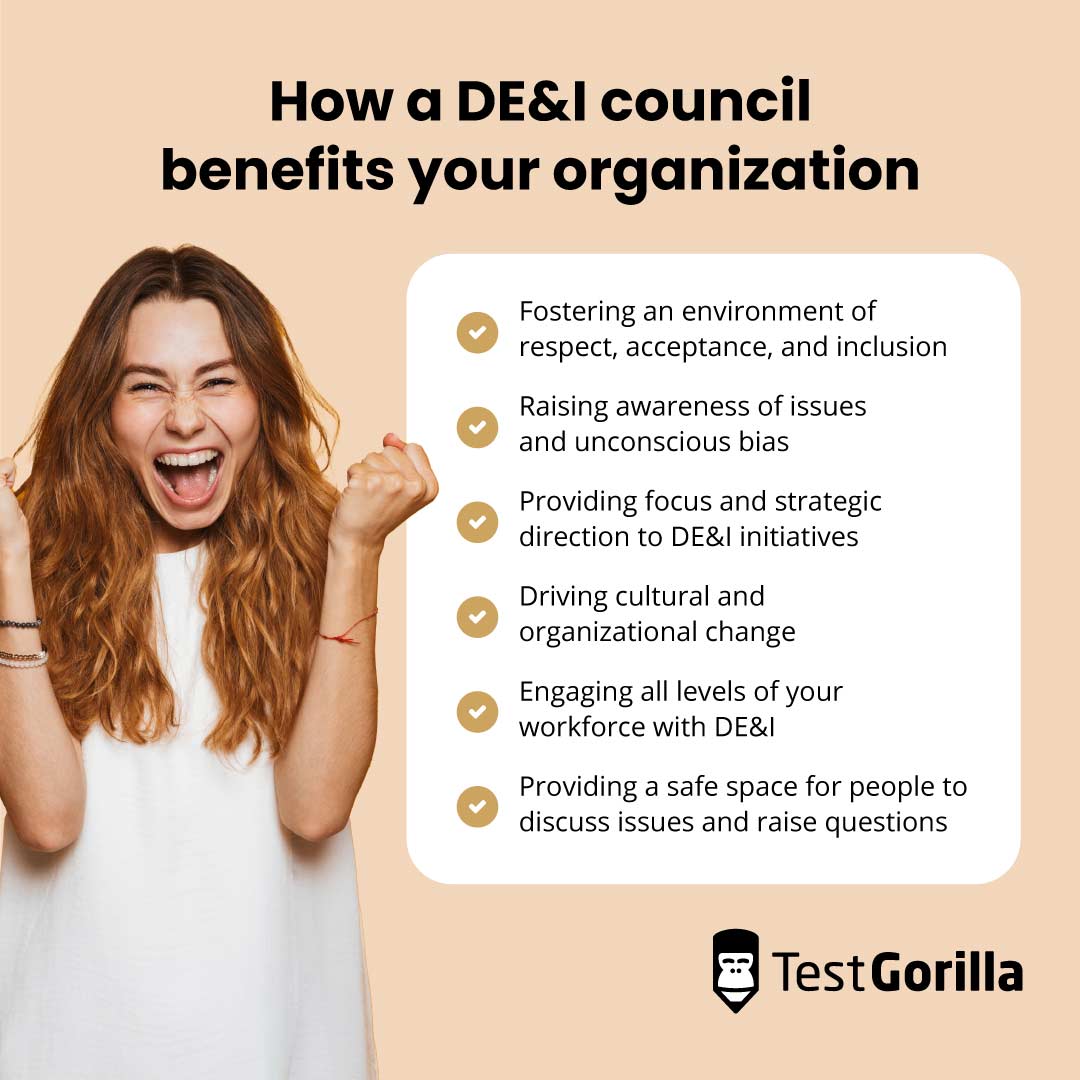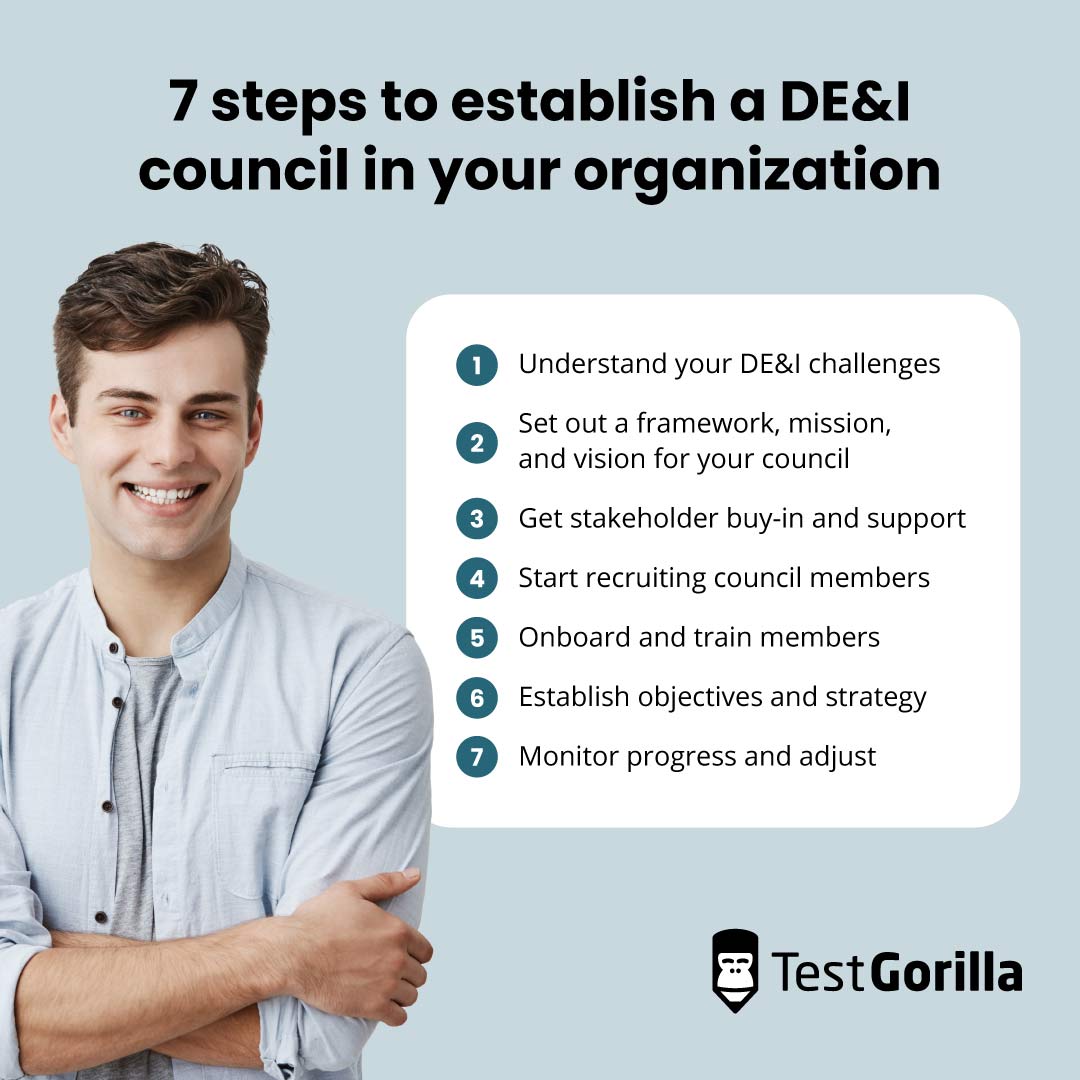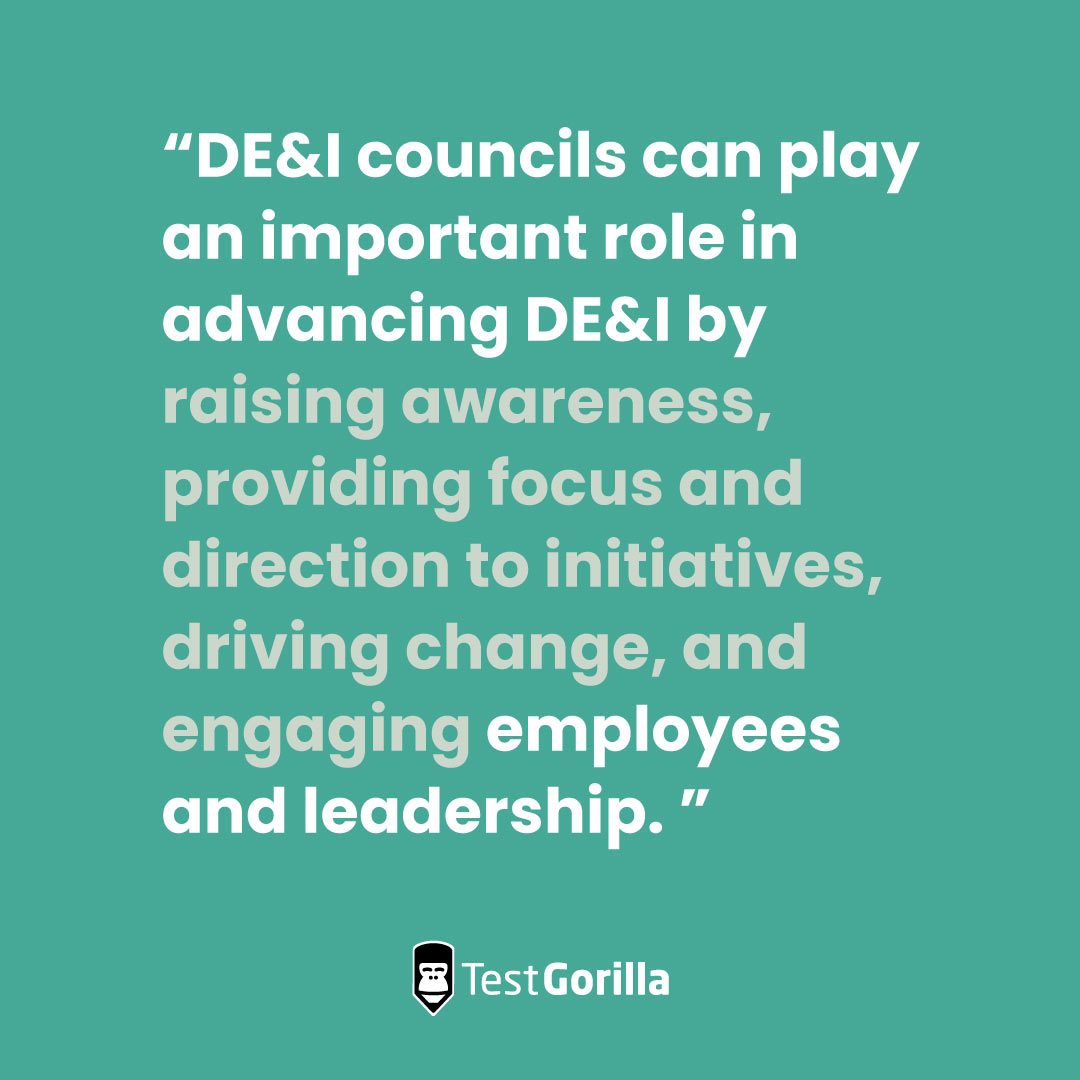It’s well known that diverse teams perform better,[1] but getting them through the door is only part of the equation. You need to create an inclusive environment to retain talent long-term and maximize ROI on hiring.
With 54% of people prepared to quit in the first six months due to factors like a toxic workplace or lack of cultural alignment, that’s no easy task.
Diversity, equality, and inclusion (DE&I) councils are now emerging as one way to drive DE&I efforts in your organization. These committees represent different employee groups and they can advise on and enact initiatives to boost DE&I and help enable wider organizational goals.
In this post, we’ll look at the benefits and challenges of establishing a DE&I council in your organization and how to go about it. Additionally, we’ll outline the key soft skills that can set council members up for success and how to identify and develop them.
Table of contents
What is a DE&I council?
A DE&I council is a body that represents different employee groups and perspectives in an organization. With this in mind, DE&I councils are ideally – though not always – composed of people from diverse backgrounds.
The activities of a DE&I council may be extremely broad, spanning everything from providing feedback to leadership to creating and implementing DE&I policies.
There are two basic types of DE&I council:
1. Members are drawn from senior leadership or roles with decision-making power. Their function is to create, promote, and enact DE&I initiatives in their respective areas. These councils are unlikely to be highly diverse since the C-level remains homogenous in many organizations.
2. A voluntary body of junior to mid-tier employees. Members represent different backgrounds, ethnicities, genders, age groups, sexual orientations, neurodiverse profiles, etc. They contribute insights into their lived experience, as well personal reflections on how DE&I initiatives are performing and how they could be improved. This council may work with those charged with enacting initiatives, rather than being directly responsible for deployment.
Depending on your needs and the size of your organization, you might have both types of council, a mix of the two, or even one that includes external experts. Either way, most councils will have a chair with DE&I expertise to guide members.
DE&I councils differ from affinity or employee resource groups in that they represent all employees in the organization, rather than a specific group. However, they can and often do work closely with ERGs, whose members may sit on the council.
How does a DE&I council benefit your organization?
A DE&I council is 100% focused on advancing DE&I in your organization. In the case of leadership councils, that means you get a powerful group of key stakeholders who are invested in DE&I and can effect real change.
In the case of employee-led councils, members can contribute valuable on-the-ground insights that management may not be aware of. Additionally, diverse teams can transform your business, leading to greater creativity, innovation, and problem-solving. Therefore, a diverse council membership brings the same benefits to advancing DE&I.
In general, DE&I councils benefit your organization by:
Fostering an environment of respect, acceptance, and inclusion
Raising awareness of issues and unconscious bias
Providing focus and strategic direction to DE&I initiatives
Driving cultural and organizational change
Engaging all levels of your workforce with DE&I
Providing a safe space for people to discuss issues and raise questions
All this benefits your DE&I efforts and your company culture and reputation.
Having a diverse HR department is known to benefit DE&I, especially as this is the first point of contact for diverse candidates. However, if you don’t have this, a DE&I council can be very helpful in achieving your goals for diversity, equity, and inclusion. This is because it sends a message that you’re committed to DE&I, which makes you more attractive to diverse talent.
Now you understand the benefits, let’s take a look at how to set up a DE&I council in your organization.
7 steps to establish a DE&I council in your organization
While DE&I councils have many benefits, they also face certain challenges. For example, lack of stakeholder buy-in, which can lead to insufficient resources and support. A lack of data and employee engagement can also hamper efforts to prioritize and enact initiatives.
Let’s explore how to overcome those challenges and set your DE&I council up for success.
1. Understand your DE&I challenges
DE&I councils exist to tackle DE&I issues, which means you first need to understand what problems different segments of your workforce might be facing. This will ensure the council’s efforts are in line with your overarching goals.
For example, perhaps you do well at hiring women to entry-level positions, only to have them drop out when they reach middle management. To understand why, you need to gather data from across your organization. For example, on employee and department demographics, company culture, results from employee development programs, complaints to HR, etc. You can also run anonymous surveys or focus groups to understand employee experiences.
When you analyze the data, you realize your management team is almost exclusively older white men with ingrained negative stereotypes about women’s ability to lead. Once you know this, you can take action to address the issue and create a more supportive environment for women leaders.
2. Set out a framework, mission, and vision for your council
With your organization’s DE&I goals clear, the next step is to write a mission and vision statement for your council. This should also align with your company mission.
For example, at TestGorilla, our mission is to place a billion people in dream jobs through objective, unbiased testing methods. Therefore, our DE&I council’s mission could be to ensure our own hiring and promotion practices are 100% free from bias.
Based on your goals, decide whether you need a leadership or employee-led council. Then, define roles, responsibilities, and expectations for members. For example, leaders may be accountable for increasing diversity in their departments or at leadership level. Employees may be responsible for gathering and analyzing data and making recommendations.
Other things to establish include:
The time commitment required
Length of member tenure
Criteria to select or replace members
Frequency and format of meetings
Scope of initiatives
Oversight, accountability, and reporting
Budget
Communication and employee engagement plan
KPIs and metrics to measure success
3. Get stakeholder buy-in and support
A lack of stakeholder buy-in will sink DE&I initiatives faster than the Titanic. This means you need to cultivate allies with decision-making power who can support your objectives.
For example, if one of your goals is to level the playing field for diverse candidates by switching to skills-based hiring, you’ll need your head of HR on board. You’ll also need approval from finance to sign up for pre-employment talent assessments.
Start with your leadership team before targeting department heads and middle management. For voluntary employee-led councils, managers will need to ok people taking time out to participate. An executive sponsor can help senior figures see the value of council recommendations and consent to initiatives that will affect their departments.
Finally, engage employees by explaining the importance of DE&I and how the council’s work will benefit them. This helps mitigate pushback from majority groups for whom the status quo is working fine.
Once you start running initiatives, you’ll need a communication plan to keep everyone informed via presentations, mailings, intranet messages, or similar. Messages should be designed to inform, educate, and engage by making the benefits to them and your organization clear.
4. Start recruiting council members
How you recruit council members will depend on whether it's a top-down initiative or a voluntary, employee-led body.
Leadership councils should ideally involve members from each business unit or level of management. For example, chief technology officer, head of product, VP of marketing, etc. If you put the work in to get buy-in, persuading them to participate will be easier.
For employee-led organizations, invite employees from different departments, roles, and backgrounds to apply or ask others, including leadership, to nominate them. In applications, ask them to explain why they want to participate and what they bring to the table.
While not essential, previous experience of DE&I is a bonus. The work won’t be easy, so council members who are aware of DE&I issues and prepared for the challenges are likely to be more resilient.
Once applications are in, elect council members and leaders and, if appropriate, assign people to sub-committees. For example, you might have a group focusing on closing the gender employment gap or working to create a more inclusive workplace for trans or LGBTQ+ people. Look to include people from relevant backgrounds or experience in these groups so they can empathize with those they’re trying to help.
5. Onboard and train members
Unless council members are DE&I experts, they’re likely to need some training, especially junior or mid-tier employees.
Thorough onboarding will set the council up for greater productivity and success from the word go. Therefore, you should design an onboarding program covering aspects like:
The organization’s business and DE&I goals and how the council’s work ties into them
Their roles and responsibilities
Lines of collaboration and reporting
Time commitment, frequency of meetings, etc.
DE&I issues
Unconscious bias
Inclusive behavior like sharing gender pronouns, unconscious bias training, etc.
You can also use talent assessments to develop the soft skills members need to handle sensitive situations involving people from different backgrounds. For example, open communication, active listening, empathy, and conflict management.
Some useful tests include:
Personality tests like 16 personalities test, Enneagram, Big 5 (OCEAN), and DISC
6. Establish objectives and strategy
Based on your DE&I and company goals, council members can establish areas of action, goals, and how much time and money it will take to achieve them. They can then prioritize based on the availability of resources and how their goals tie into wider company ones.
Areas of action might include collaborating with ERGs, gathering data and employee feedback, hiring more talent from underserved communities, or developing leaders from underrepresented groups.
Then, draw up policies or initiatives to achieve these goals. For example:
Providing transport to work for people in outlying neighborhoods with no public transport
Overhauling benefits packages, like providing childcare so working mothers can attend out-of-hours leadership meetings
Break down big goals into smaller objectives that are specific, measurable, achievable, relevant, and time-bound (SMART). For example, “increase LGBTQ+ diversity at C-level” is too broad. However, “get 10 executives to participate in unconscious bias training by end-of-quarter” is concrete, measurable, and achievable in a specific timeframe.
7. Monitor progress and adjust
Once you’re up and running, you should track and evaluate the impact of initiatives. Schedule regular reviews to evaluate the success of individual initiatives and overall progress.
For example, if you ran awareness training covering what constitutes a microaggression, survey participants and victims, and check incident reporting data before and after. This allows you to evaluate changes in attitudes and whether incidents have decreased or whether victims feel more comfortable reporting them.
You should also track candidate and employee demographics over time to see how they changed, as well as metrics like pay equality, employee satisfaction, turnover, and promotion rates. This will tell you whether your efforts are feeding into wider organizational goals.
H2 DE&I councils: Another valuable tool in your DE&I kit
Diverse teams perform better, but building and retaining them can be an uphill struggle. You can hire more diverse candidates, but unless you put the work in to make them feel welcome, you could lose them.
DE&I councils can play an important role in advancing DE&I by raising awareness, providing focus and direction to initiatives, driving change, and engaging employees and leadership.
To create one, start by understanding your DE&I goals and how the council’s work will tie in. Then, establish a framework, mission, and vision, get stakeholder buy-in, recruit and onboard members, and set objectives and success metrics.
Along the way, you can develop essential soft skills like active listening, conflict management, and leadership using talent assessments. These both help set council members up for success and translate into valuable skills they can use in their day-to-day work.
Hire more diverse teams that perform better. Skills-based hiring lets you hire the right people for your open roles based on what they can do, not who they are. |
Sources
“Diversity wins: How inclusion matters” McKinsey (2020). Retrieved September 21, 2023. https://www.mckinsey.com/featured-insights/diversity-and-inclusion/diversity-wins-how-inclusion-matters
“Poll Results: Quick Quitting” Monster (2022). Retrieved September 21st, 2023. https://learnmore.monster.com/poll-results-quick-quitting
Related posts
Hire the best candidates with TestGorilla
Create pre-employment assessments in minutes to screen candidates, save time, and hire the best talent.
Latest posts
The best advice in pre-employment testing, in your inbox.
No spam. Unsubscribe at any time.

Hire the best. No bias. No stress.
Our screening tests identify the best candidates and make your hiring decisions faster, easier, and bias-free.
Free resources
This checklist covers key features you should look for when choosing a skills testing platform
This resource will help you develop an onboarding checklist for new hires.
How to assess your candidates' attention to detail.
Learn how to get human resources certified through HRCI or SHRM.
Learn how you can improve the level of talent at your company.
Learn how CapitalT reduced hiring bias with online skills assessments.
Learn how to make the resume process more efficient and more effective.
Improve your hiring strategy with these 7 critical recruitment metrics.
Learn how Sukhi decreased time spent reviewing resumes by 83%!
Hire more efficiently with these hacks that 99% of recruiters aren't using.
Make a business case for diversity and inclusion initiatives with this data.






















